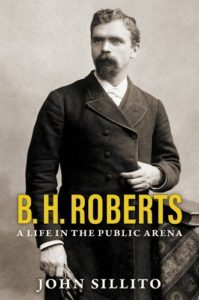 Title: B. H. Roberts: A Life in the Public Arena
Title: B. H. Roberts: A Life in the Public Arena
Author: John Sillito
Publisher: Signature Books, Salt Lake City
Genre: Biography
Year Published: 2021
Number of Pages: 585
Binding: Hardback
Price: $34.95
Reviewed by Erik Champenois
B. H. Roberts: A Life in the Public Arena, is, as the title implies, not a complete biography, but rather a biography of B.H. Robert’s public life – both in the church and in politics. The book only partially covers Roberts’ personal life and just barely mentions his theological thought and writings. While I found myself wanting to read a longer and more holistic book to understand Roberts and his thinking more fully, that isn’t the kind of book the author set out to write. Instead, the author wrote a book that is vital for understanding the LDS Church vis-à-vis Utah and national politics during the era of Mormonism’s transition from the 1880s through 1933.
The book shines in particular in its treatment of B.H. Roberts’ run for Congress in 1898 and the subsequent successful resistance to him taking his seat. It also helps you better understand the dynamics of how polygamy and its end impacted the personal and public life of B.H. Roberts and of the LDS Church and its members as a whole. B.H. Roberts became a polygamist in 1884 and had difficulties accepting the Manifesto when it (mostly) ended new polygamous marriages in 1890. Interestingly, B.H. Robert’s marriage to his third wife most likely took place after the Manifesto. While the Manifesto ended new polygamous relationships, it did not end existing ones and Roberts continued to cohabit (in separate houses) with all three of his wives until their/his deaths. (Looking back, I wonder how frequent continuously existing polygamous marriages would have been in local Utah communities as late as the 1930s and 1940s). Roberts apparently also felt free to seriously flirt with the much younger Leah Dunford in 1897 (encouraged by her mother, Susa Young Gates) – one of the book’s juicier parts.
Sillito focuses particularly on politics and demonstrates just how divided church leaders were amongst themselves when it came to politics. While Church members had traditionally been Democrats, church leaders (and until the Depression, church members) under Joseph F. Smith became predominantly Republican. The tensions that resulted from church leaders speaking out on politics or even running for office even resulted in Apostle Moses Thatcher being dropped from the Quorum of the Twelve (and nearly could have resulted in B.H. Roberts himself losing church office). Frankly, while I understand that some amount of rulemaking and discipline needed to be enforced for church leaders, some of the conversations recounted in the book make some of the church leaders of the time seem sometimes more infatuated with enforcing their own authority than with striving for the unity of the church.
While covering politics, the book also covers B.H. Robert’s impressive service as a missionary and mission leader. B.H. Roberts became most famous within the Church for his efforts to secretly secure the bodies of the two missionaries killed in Tennessee in 1884. He also preached the Gospel in England and served as mission president of the Eastern States Mission. He was admired as a preacher and proponent of missionary work and was the first one to develop a standardized set of missionary lessons.
B.H. Roberts doesn’t always come across as likeable or admirable, however. In spite of being considered one of Mormonism’s foremost theological thinkers, his personal manners could be needlessly antagonistic. Roberts had his enemies, including as a result of him campaigning against women’s suffrage. And, unsurprisingly, he had favorites among his plural wives and did not care equally for them, leading to tensions between the different parts of his family. Roberts comes across in this book as fully human, but also as one with a wild and interesting life history. While I would have liked to have read more about his theology, in the end this examination of his public life proves at least as interesting as a book on his theology would have been.
